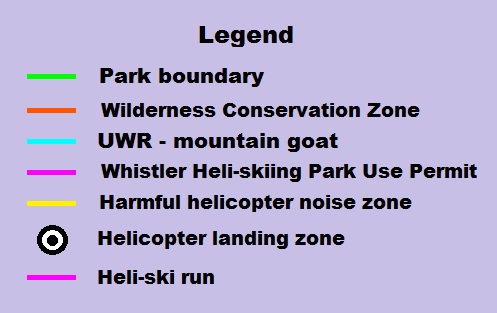I spoke with a statistician friend of mine today about the Tetrahedron Provincial Park survey. The survey was prepared by BC Parks to gauge public support for three options to enable additional water extraction beyond what is currently allowed in the Class A provincial park. The options would re-designate the park as a conservancy or protected area with lesser protection. Thee designations would allow development of additional water infrastructure and perhaps ancillary infrastructure and development such as dams, logging and roads, even. The terms of what is allowed are determined by the Minister of Environment or delegates as guided by the Protected Areas of British Columbia Act.
The three lesser protection options are:
- Option 1: Re-designate the entire park to a protected area.
- Option 2: Re-designate a portion of the park to a protected area, presumably Chapman and Edwards lakes, Chapman Creek etc. with the remaining area left as Class A park.
- Option 3: Re-designate the entire park as a conservancy.
It is a basic principal of surveys that you ask all survey participants the same set of questions. BC Parks held two open houses on the Sunshine Coast and gave out a printed questionnaire to attendees. For those who were unable to attend, BC Parks directed them to an online questionnaire. The printed and online questionnaires are substantially different. Different questions were asked.
The printed version itemized the three options above plus an additional, unnumbered option to preserve the park as is—the status quo. In contrast, the online version only asks the respondent for thoughts on the three re-designation options without itemizing what those options are and neglecting to mention the status quo as an option. The online version also did not invite for comments on the status quo.
The printed version includes checkboxes by which a preferred option is selected—one of the three numbered options above plus the status quo option. Selection is an unambiguous yes or no.
The online version does not allow for selection of an option unambiguously. There is not a clear yes or no question. The tone is different. The first two questions are somewhat problematic. In answering, the respondent would enable the survey analyst to assess the respondent's depth of knowledge of the issues. The fact the same questions do not appear on the printed version is concerning.
Both versions contain an optional contact information section. However, the printed version would more than likely originate from a Sunshine Coast resident. But, by the response to the first question in the online version, the survey analyst would be able to make a reasonably accurate guess as to where the respondent lived, be it on the Sunshine Coast or elsewhere. It could be indicative of geographic profiling that could be used by an analyst to bolster or discount certain survey responses based on where the respondent is imputed to live. For example, an analyst may choose to boost responses from the Sunshine Coast and discount responses from Metro Vancouver.
According to the statistician, the survey is invalid. Not only are there two different sets of questions but the online version is clearly biased against the status quo. Even someone with only rudimentary knowledge of survey techniques would understand there is bias and the survey is worthless.
The printed open house comment form can be viewed here: Tetrahedron Open House Comment Form (2018-05-02)
The online comment form can be viewed here: Tetrahedron Online Comment Form (2018-05-02)
If you think about it, the lack of an open house in Metro Vancouver is troubling enough. Tetrahedron Park, due to its hut system and proximity to the large Metro population makes it a feasible and attractive overnight destination for Metro residents. Many Metro residents are strong supporters of the status quo option. They are more likely to fill out the online questionnaire since attending an open house on the Sunshine Coast is costly and takes up a full day including travel on the ferry. Those submitting the online questionnaire are less likely to know that the status quo is an option because it was not presented as an option. Metro residents would be unduly influenced by the bias on the questionnaire towards the re-designation options.
The integrity of the entire process is brought into disrepute by the unscientific survey developed by BC Parks. Whether or not the bias and errors in methodology are intentional or not, there is no choice but to disregard the worthless survey results and start the entire consultation process over again from the beginning. There can be no legitimate decision reached from such a tainted process.




